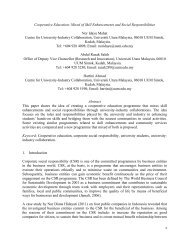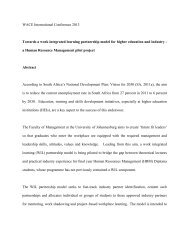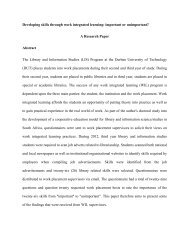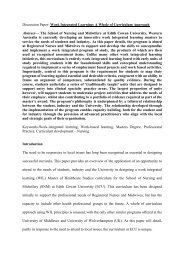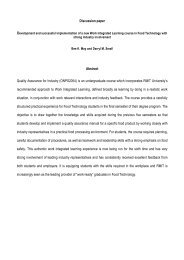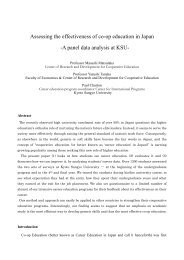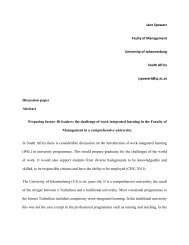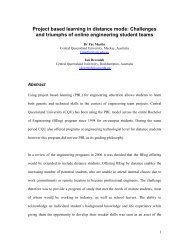Ingrid Apsitis, University of Tasmania (non-refereed ... - WACE
Ingrid Apsitis, University of Tasmania (non-refereed ... - WACE
Ingrid Apsitis, University of Tasmania (non-refereed ... - WACE
You also want an ePaper? Increase the reach of your titles
YUMPU automatically turns print PDFs into web optimized ePapers that Google loves.
Sustaining a WIL Community on an Island – Triumphs & Tribulations – A Case Study: Corporate Internship Program, Faculty<strong>of</strong> Business, <strong>University</strong> <strong>of</strong> <strong>Tasmania</strong>, Australia6placement is being <strong>of</strong>fered, and, have passed at an acceptable level, sufficient study unitsapplicable to the requirements <strong>of</strong> the internship project.Internship Business Organisation RequirementsMentor – the business organisation provides a suitable staff person/s to mentor the student,provide guidance to them in the workplace during the internship, and assist withworkplace assessment using a pr<strong>of</strong>orma developed by the Faculty.Access – the business organisation provides access to suitable facilities, equipment,personnel and information necessary for the student to successfully complete their projectand/or related business tasks.Stakeholder EngagementEngaging stakeholders successfully is a key factor in setting up and sustaining any WILprogram (Lawson, et al, 2011; Cooper, et al, 2012; Stefani, 2009). It is particularlysignificant for a work-based, business-oriented WIL program such as the CIP.One <strong>of</strong> the first challenges in setting up the CIP was engaging participants from the businesscommunity. There were concerns that limited employment opportunities in <strong>Tasmania</strong> wouldbe replicated by limited internship opportunities for students.To facilitate engagement, a combination <strong>of</strong> marketing strategies was deployed in the firstinstance that could be applied to all stakeholders. A website for the CIP was developed in thefirst year <strong>of</strong> operation to facilitate access by students, academics and business organisationsto a suite <strong>of</strong> common services and shared information. This was driven by demand forspecific information requests from business organisations and students, and avoided the needfor duplicated written and telephone responses by the Program Director. Information wascentred round procedures for accepting internship project proposals, prospective internship<strong>WACE</strong> 18 th World Conference on Co-operative and Work-integrated Education June 24 – 27, 2013 Durban South Africa
Sustaining a WIL Community on an Island – Triumphs & Tribulations – A Case Study: Corporate Internship Program, Faculty<strong>of</strong> Business, <strong>University</strong> <strong>of</strong> <strong>Tasmania</strong>, Australia8Business -‐ submits internship project briefonline at CIP websiteStudent -‐ expresses interest online inadver@sed project(s)Project brief received by Program Director thenforwarded to relevant academic for approval andfeedback.Student eligibility checked against Program criteria(with advice from Faculty Academic Administra@onstaff and School Coordinators) and the project brief.Business no@fied <strong>of</strong> academic response to projectproposal (i.e., approval/need for amendment/rejec@on, <strong>of</strong> project proposal.Eligible student interviewed by business(es) .Student prepares for interview using strategiesrecommended by the Program Director and theCareers Service.If approved, project details adver@sed on CIPwebsite for perusal by students.Successful interview = <strong>of</strong>fer <strong>of</strong> internship bybusiness. If student accepts <strong>of</strong>fer then can enrol inrelevant internship unit. Pre-‐internship informa@onforwarded to new intern.Business receives no@fica@on from ProgramDirector <strong>of</strong> eligible candidate(s) ready for interview.Business conducts interview, makes selec@on,no@fies successful applicant and Program Director,if applicant accepts <strong>of</strong>fer.Internship period commences in first week <strong>of</strong>semester. Hosted by Program Director, compulsorybriefing sessions are held on each campus viavideolink for all new interns. School Coordinatorsare required to aPend.Contract prepared and forwarded to business,confirming candidate, condi@ons <strong>of</strong> internship andproject details. Business Mentor, intern andProgram Director sign <strong>of</strong>f on Contract.Contract signed. Helpful informa@on emailed to allnew interns. Tips for managing the internship andexpecta@ons forwarded to business mentor (andcopied to intern) by Program Director.Student EngagementEngaging students in the CIP required execution <strong>of</strong> a number <strong>of</strong> different marketinginitiatives. In addition to information provided on the CIP website, facilitating involvementby students was achieved by holding information sessions for prospective interns on thelargest <strong>of</strong> the three UTAS campuses located in the South <strong>of</strong> the State, which were then videolinkedto the two other campuses located in the North, and on the North-West coast,respectively. The Dean was very supportive <strong>of</strong> the CIP from its inception and keen to lend hisname to bulk emails promoting the Program to students.Marketing the CIP to students was relatively easy in the early stages as students were keen toengage with a new learning environment. They also assumed (incorrectly) that an internship<strong>WACE</strong> 18 th World Conference on Co-operative and Work-integrated Education June 24 – 27, 2013 Durban South Africa
Sustaining a WIL Community on an Island – Triumphs & Tribulations – A Case Study: Corporate Internship Program, Faculty<strong>of</strong> Business, <strong>University</strong> <strong>of</strong> <strong>Tasmania</strong>, Australia9would be reminiscent <strong>of</strong> their mostly, passive work experience undertaken during theirsecondary schooling, and provide them with an easy learning option. It took one semesteronly <strong>of</strong> successfully completed internships for students to realise corporate internships studyunits were aimed at self-directed learners and required considerable effort on their part tomeet business expectations and achieve desired academic outcomes. Nevertheless, byparticipating in the CIP, benefits to students were immediately obvious and warranted furtherinterest.The internship project is individually tailored to complement and/or augment graduateattributes the student has acquired during their university studies (and elsewhere) and relatesto at least one <strong>of</strong> their majors. This is a deliberate strategy to ensure the student:is aware <strong>of</strong> the importance <strong>of</strong> UTAS graduate attributes (knowledge, problem solvingskills, communication, social responsibility, global perspective);can critically reflect on the attributes they have acquired, or will acquire, during theirdegree in the Faculty <strong>of</strong> Business;gains skills, capabilities and knowledge relating to their degree and area <strong>of</strong> interest in anenvironment that correlates with their intended career path; and,can make a positive contribution to a <strong>Tasmania</strong>n business organisation.Solicited feedback from questionnaires and online Discussion Posts by first and subsequentintakes <strong>of</strong> interns revealed a number <strong>of</strong> recurrent themes with regard to advantages <strong>of</strong>Program participation. Self-confidence, application <strong>of</strong> university studies to the corporateenvironment, deeper understanding <strong>of</strong> academic theory and its relation to corporate practice,networking opportunities, critical analysis <strong>of</strong> career plans, and personal and pr<strong>of</strong>essionaldevelopment have been cited as the most common benefits derived from Program<strong>WACE</strong> 18 th World Conference on Co-operative and Work-integrated Education June 24 – 27, 2013 Durban South Africa
Sustaining a WIL Community on an Island – Triumphs & Tribulations – A Case Study: Corporate Internship Program, Faculty<strong>of</strong> Business, <strong>University</strong> <strong>of</strong> <strong>Tasmania</strong>, Australia11applicability and limitations <strong>of</strong> university studies in preparing them for corporate practice.The process <strong>of</strong> academic acceptance took some time, nevertheless, after the first twosemesters <strong>of</strong> operation, the benefits <strong>of</strong> the Program to students, the Faculty, and the<strong>Tasmania</strong>n business community could not be ignored or regarded as a stroke <strong>of</strong> luck.This change in attitude coincided with an emphasis by UTAS and other Australianuniversities on strengthening business partnerships and furthering opportunities forcommunity engagement. As part <strong>of</strong> the Australian federal government’s higher educationenterprise agenda, WIL was perceived as an ideal process for facilitating partnerships, toaddress skills shortages with a supply <strong>of</strong> work-ready graduates and meet future needs <strong>of</strong>Australian and international labour markets (Review <strong>of</strong> Australian Higher Education: FinalReport (2008); Transforming Australia’s Higher Education System (2009). Challengespreviously met by individuals at a program level, were immediately thrust into the spotlightnationally, as overarching, institutional concerns worthy <strong>of</strong> specific policy-development,infrastructure and resources (Cooper, et al, 2010; Orrell, 2011).Risk Management and Quality assuranceProgram StructureSetting up a WIL program involves contending with numerous, well-documented, risks thatneed to be carefully managed, including: discrimination, quality assurance in relation toworkplace supervision, assessment and WIL opportunities, maintaining standards involved induty <strong>of</strong> care, student competency and preparedness, managing stakeholder expectations, anduniversity policies and procedures (Cooper, et al, 2010; Patrick, et al, 2008). With regard tothe above, ensuring a quality WIL experience for all CIP participants has fostered an<strong>WACE</strong> 18 th World Conference on Co-operative and Work-integrated Education June 24 – 27, 2013 Durban South Africa
Sustaining a WIL Community on an Island – Triumphs & Tribulations – A Case Study: Corporate Internship Program, Faculty<strong>of</strong> Business, <strong>University</strong> <strong>of</strong> <strong>Tasmania</strong>, Australia12adaptable Program management structure that can accommodate procedures for riskidentification,mitigation (where possible) and effective management.Striking the correct balance between WIL enablers and impediments can be tricky (Lawson etal, 2011). When the CIP commenced in 2007, UTAS did not have a formally-endorsed up-todateposition with regard to WIL. The lack <strong>of</strong> a current UTAS WIL policy and guidingprinciples meant WIL programs at UTAS were vulnerable. Faculties had developed their own,independent procedures for managing risk and quality assurance obligations, specific to theirdiscipline area and related industry needs.In 2010, the Centre for the Advancement <strong>of</strong> Learning and Teaching (CALT) at UTAS,commenced work on ‘The WIL Project’ to develop a new Work Integrated Learning (WIL)Policy (Freeman, 2011). The UTAS Work Integrated Learning Policy was mandated in 2011,providing comprehensive guidelines for managing WIL and meeting legislative requirementsin relation to higher education support, student learning, career development learning, equity,community engagement, insurance, conflict <strong>of</strong> interest, coordination/management <strong>of</strong> WILplacements, quality assurance, risk management, disability discrimination, Workplace Healthand Safety (WHS), occupational health and safety, academic standards, intellectual propertyand student discipline, (UTAS Work Integrated Learning (WIL) Policy, 2011).At a Business Faculty level, the UTAS WIL Policy affirmed the robustness <strong>of</strong> proceduresalready in place within the CIP. It also highlighted a deficiency that was not immediatelyapparent, and therefore not identified as a risk in the early stages <strong>of</strong> Program development.By the time UTAS WIL Policy was formally endorsed in 2011, several changes had occurredwithin the CIP that involved significant risk. As stakeholder confidence in the CIP grew, the<strong>WACE</strong> 18 th World Conference on Co-operative and Work-integrated Education June 24 – 27, 2013 Durban South Africa
Sustaining a WIL Community on an Island – Triumphs & Tribulations – A Case Study: Corporate Internship Program, Faculty<strong>of</strong> Business, <strong>University</strong> <strong>of</strong> <strong>Tasmania</strong>, Australia13kinds <strong>of</strong> WIL opportunities <strong>of</strong>fered to business students became more adventurous, and theirlocations more exotic. Exciting tourism, business management and marketing-relatedinternships became available with business organisations such as the <strong>Tasmania</strong>n Parks andWildlife Service, regional (rural) councils and agribusinesses in locations around the State atconsiderable distances from major cities and towns. Suddenly, risks <strong>of</strong> snake-bite, exposureto uncommon hazards such as native animals, plants and travel-related incidents werepossibilities that needed to be taken into consideration. There was no risk assessment processin place for CIP interns required to travel large distances to remote locations or exposed tounusual hazards not encountered in city-based, <strong>of</strong>fice environments. The new UTAS WILPolicy provided guidelines for managing such risks together with a pr<strong>of</strong>orma for specificadaptation by WIL managers.Student LearningCorporate Internships comprise carefully constructed work-based projects. They are createdby business organisations using an online pr<strong>of</strong>orma developed by the CIP team. However, asBlumenfeld, et al, (1991) contend, project-based learning is unlikely to be successful unlessconstructed in such a way that with appropriate guidance, the projects themselves generateand sustain student motivation and thoughtfulness. Furthermore, they claim student interest inproject-based learning is enhanced when tasks are varied and include novel elements; theproblem is authentic and perceived by the student to have value; the project is challengingand finite, resulting in creation <strong>of</strong> an artefact; there is choice about how and what is to beachieved; and, there are opportunities to work with others. Balancing desired pedagogicaloutcomes with student interest in their WIL project, has required internship projects to bestructured in close alignment with CIP objectives to maximise the learning experience forstudents, meet business needs, and connect with the assessment rubric.<strong>WACE</strong> 18 th World Conference on Co-operative and Work-integrated Education June 24 – 27, 2013 Durban South Africa
Sustaining a WIL Community on an Island – Triumphs & Tribulations – A Case Study: Corporate Internship Program, Faculty<strong>of</strong> Business, <strong>University</strong> <strong>of</strong> <strong>Tasmania</strong>, Australia14Provision <strong>of</strong> an authentic learning experience complemented by appropriate forms <strong>of</strong>assessment has been the subject <strong>of</strong> much debate in the literature (Cooper, et al, 2010; Patrick,et al, 2008). Determination <strong>of</strong> appropriate forms <strong>of</strong> assessment and linking them to desiredstudent learning outcomes in the CIP has proven to be a challenge. Obtaining consistencywhen assessing the work <strong>of</strong> a diverse range <strong>of</strong> students, from different though related-studybackgrounds, each completing unique internship projects with differing skill requirements,has been the subject most <strong>of</strong>ten discussed and subject to most frequent refinement in the CIP.With a view to continuous improvement in all aspects <strong>of</strong> Program development, a review <strong>of</strong>the CIP is conducted at the conclusion <strong>of</strong> each academic year by the Program Director andacademics closely involved with the Program. Together with solicited (via surveys and onlinediscussion) and unsolicited feedback from student and business participants, suggestions andrecommendations for improvement are incorporated into the Program, which is constantlyevolving to meet business needs and desired student learning outcomes.SustainabilityEmphasis in the CIP has always been on the quality <strong>of</strong> potential internship experiences. Thisvision has served the Program well, with both <strong>Tasmania</strong>n business organisations and UTASbusiness students fully aware that the aim <strong>of</strong> the Program is to facilitate the best possibleoutcomes for all participants. In 2011, the CIP received formal recognition from UTAS for itscontribution to student learning, and workplace and community engagement with a Vice-Chancellor’s Award. The award enhanced the value <strong>of</strong> participation by all stakeholders andencouraged them to continue supporting the Program. Despite the accolade, there are manychallenges in sustaining the CIP. Adequate resourcing, stakeholder engagement and <strong>of</strong>fering<strong>WACE</strong> 18 th World Conference on Co-operative and Work-integrated Education June 24 – 27, 2013 Durban South Africa
Sustaining a WIL Community on an Island – Triumphs & Tribulations – A Case Study: Corporate Internship Program, Faculty<strong>of</strong> Business, <strong>University</strong> <strong>of</strong> <strong>Tasmania</strong>, Australia15a WIL business curriculum that is adaptable to changing academic and business needs arecommonly cited areas <strong>of</strong> concern for work-based learning programs (Cooper, et al, 2010,Patrick, et al, 2008, Boud and Solomon, 2001).To date, resources for the CIP have been scarce in what can only be described a very labourintensiveenterprise. Much <strong>of</strong> the extra work required has been undertaken with a fair degree<strong>of</strong> goodwill by the Program Director. Passion for the job has no financial value, yet has beenan essential ingredient in sustaining the Program. WIL is frequently regarded as the ‘poorcousin’ in academic circles with funding preferences being directed towards research in areaswhere there is proven capacity to draw in much needed capital. The CIP has thrivedregardless, evidence <strong>of</strong> the effectiveness <strong>of</strong> the current Program management structure. It willcontinue to grow provided there is sufficient support from senior management.Securing participation by well-informed, appropriately-skilled stakeholders has alsocontributed to the CIP’s success. Managing stakeholder expectations is a particularlyimportant factor in the <strong>Tasmania</strong>n corporate environment, where many <strong>of</strong> the participants areknown to each other and in regular communication. In this context, a less than idealinternship experience by a business organisation and/or student could have an immediate,adverse impact on the future <strong>of</strong> the Program.Empowering the business organisation and student applicant to be final arbiters in choosingwhether or not to proceed working together on an internship project (ref: diagram above),ensures commitment to CIP objectives at the outset and has mitigated many potentialproblems (e.g., lack <strong>of</strong> engagement with and/or commitment to the internship project). Closemonitoring <strong>of</strong> intern and business mentor by the CIP Director at every stage <strong>of</strong> the internship,<strong>WACE</strong> 18 th World Conference on Co-operative and Work-integrated Education June 24 – 27, 2013 Durban South Africa
Sustaining a WIL Community on an Island – Triumphs & Tribulations – A Case Study: Corporate Internship Program, Faculty<strong>of</strong> Business, <strong>University</strong> <strong>of</strong> <strong>Tasmania</strong>, Australia16facilitates regular communications between all parties and further mitigates escalation <strong>of</strong>problems should they arise. A placement visit by the Program Director in the middle <strong>of</strong> thethree month internship period has proven a valuable exercise in identifying potential issuesand being able to diplomatically discuss these in an informal setting (the placement visit doesnot form part <strong>of</strong> an intern’s assessment).In the first year <strong>of</strong> the CIP, a lack <strong>of</strong> cultural awareness by a small sector <strong>of</strong> the <strong>Tasmania</strong>nbusiness community needed to be addressed. Some <strong>Tasmania</strong>n businesses were scepticalabout working with interns from overseas, especially those lacking prior knowledge <strong>of</strong>Australian corporate culture. To remedy this, the Faculty <strong>of</strong> Business commenced <strong>of</strong>feringrelevant study units at postgraduate level (BAA711 Workplace Attributes and BAA702Engaging with the Global Workplace), with the knowledge that many newly-arrived,postgraduates from a <strong>non</strong>-English speaking background would be interested in applying forcorporate internships in the final year <strong>of</strong> their degree. Despite initial reluctance by the<strong>Tasmania</strong>n business community to engage with international learners, the realisation thatparticipation in the CIP represented a relatively low risk to the business (unlike paidemployment), and carried no financial burden (corporate internships are unpaid), the situationwas reversed fairly quickly with an acquired understanding that business students who wereeligible to participate in the CIP, were also highly capable and keen to make theircontribution to the <strong>Tasmania</strong>n community.With regard to sustaining the CIP into the future, development <strong>of</strong> a learning culture in theFaculty <strong>of</strong> Business at UTAS via participation in the Program, has come full circle. At theconclusion <strong>of</strong> each semester, many interns go on to paid employment with the organisationsthat hosted them. Securing employment at the end <strong>of</strong> an internship is not mandated as it<strong>WACE</strong> 18 th World Conference on Co-operative and Work-integrated Education June 24 – 27, 2013 Durban South Africa
Sustaining a WIL Community on an Island – Triumphs & Tribulations – A Case Study: Corporate Internship Program, Faculty<strong>of</strong> Business, <strong>University</strong> <strong>of</strong> <strong>Tasmania</strong>, Australia17would be risky in an island State that also has the highest rate <strong>of</strong> unemployment in thecountry. (ABS, 2013). For interns who choose to remain in <strong>Tasmania</strong> at the conclusion <strong>of</strong>their degrees, it is important they retain positive, memorable experiences <strong>of</strong> their internships.In recent years, a number <strong>of</strong> former interns from the first two years <strong>of</strong> the CIP cohort andnow occupying middle and senior management positions with well-known, <strong>Tasmania</strong>nbusinesses, have been instrumental in encouraging their organisations to <strong>of</strong>fer internshipprojects and have taken it upon themselves to mentor new generations <strong>of</strong> corporate interns.Added to the number <strong>of</strong> organisations who repeatedly take UTAS business interns, the latterhave made a significant contribution to the sustainability <strong>of</strong> the Program. Former businessmentors, who have moved on to key roles with some <strong>of</strong> <strong>Tasmania</strong>’s peak industry bodies,have also been highly effective at leveraging further internship opportunities in theorganisations they represent.ConclusionIn this paper, stakeholder engagement has emerged as the salient theme. Several mainchallenges associated with the management and structure <strong>of</strong> the CIP to engage stakeholdershave been explored. In addition to providing an academic challenge for students and meetingthe needs <strong>of</strong> business, the CIP has fostered a learning culture in which the social value <strong>of</strong>business, the role <strong>of</strong> government, individual responsibility and collective accountability arecritically examined in relation to participants’ beliefs, values and goals. The CIP hasfacilitated a learning environment in which our future business leaders and thinkers recognisethe importance <strong>of</strong> higher order thinking in dynamic social, political and economic conditions.Importantly, for Faculty <strong>of</strong> Business students (and aspiring future managers), the direction <strong>of</strong>contemporary UTAS management is favourable for integrative learning opportunities such asthose <strong>of</strong>fered by the Corporate Internship Program. WIL is now recognised by business<strong>WACE</strong> 18 th World Conference on Co-operative and Work-integrated Education June 24 – 27, 2013 Durban South Africa
Sustaining a WIL Community on an Island – Triumphs & Tribulations – A Case Study: Corporate Internship Program, Faculty<strong>of</strong> Business, <strong>University</strong> <strong>of</strong> <strong>Tasmania</strong>, Australia18leaders and academics as one <strong>of</strong> the most effective ways to improve skills, increaseproductivity and change corporate structures to better serve communities (Choy, et al, 2009).<strong>Tasmania</strong>’s current and future, economic and social development depends on thecontributions <strong>of</strong> well-trained, productive citizens.References:Australian Bureau <strong>of</strong> Statistics website: Labour Force Commentary April 2013, Retrieved 3rdJune 2013, from http://www.abs.gov.au/ausstats/abs@.nsf/Latestproducts/6202.0MainFeatures2Apr 2013?openBiggs, J. B. (2003), Teaching for quality learning at university: what the student does.Buckingham, Society for Research into Higher Education & Open <strong>University</strong> PressBillet, S. (2001), Learning in the Workplace: strategies for effective practice. Crows Nest,NSW, Australia, Allen & Unwin,Blumenfeld, P., Soloway, E., Marx, R., Krajcik, J., Guzdial, M. & Palincsar, A. (1991).Motivating Project-Based Learning: Sustaining the Doing, Supporting the Learning,Educational Psychologist, Vol. 26, Number 3 & 4, pp. 369-398Boud, D & Solomon, N., (eds), (2001). Work Based Learning: A New Higher Education? :Buckingham, The Society for Research into Higher Education & Open <strong>University</strong> Press, pp.18-33Brown, N. (2010), WIL(ling) to share: an institutional conversation to guide policy andpractice in work-integrated learning, Higher Education, Research and Development, Vol 29,No. 5, October 2010, 507-518Choy, S. & Delahaye, B. (2009) A sustainable model for university-industry learningpartnership: Issues for universities, ANZAM 2009 Conference, 1-4 December 2009,<strong>WACE</strong> 18 th World Conference on Co-operative and Work-integrated Education June 24 – 27, 2013 Durban South Africa
Sustaining a WIL Community on an Island – Triumphs & Tribulations – A Case Study: Corporate Internship Program, Faculty<strong>of</strong> Business, <strong>University</strong> <strong>of</strong> <strong>Tasmania</strong>, Australia19Southbank, Melbourne, QUT Digital Repository: http://eprints.qut.edu.au Retrieved October6, 2010Commonwealth <strong>of</strong> Australia (2008). Review <strong>of</strong> Australian Higher Education: Final Report,Department <strong>of</strong> Education, Employment and Workplace Relations, Canberra: Commonwealth<strong>of</strong> AustraliaCommonwealth <strong>of</strong> Australia (2009). Transforming Australia’s Higher Education System,Commonwealth <strong>of</strong> Australia. Canberra: Commonwealth <strong>of</strong> AustraliaCooper, L., Orrell, J & Bowden, M. (2010), Work Integrated Learning: A Guide to EffectivePractice, London: RoutledgeFreeman, B., Brown, N. & Spurr, M. (2011). The role <strong>of</strong> collaborative policy development inprogressing the UTAS WIL agenda. <strong>University</strong> <strong>of</strong> <strong>Tasmania</strong>. Retrieved 24 th May, 2014 fromhttp://www.utas.edu.au/_data/assets/pdf_file/0006/186282/Freeman-Brown-and-Spurr-WIL-Paper.pdf.Freudenberg, B., Brimble, M., & Cameron, C., (2011), WIL and generic skill development:The development <strong>of</strong> business students’ generic skills through work-integrated learning, Asia-Pacific Journal <strong>of</strong> Cooperative Education, 2011, 12(2), 79-93Lawson, R., Fallshaw, E., Papadopoulos, T., Taylor, T. & Zanko, M. (2011). Pr<strong>of</strong>essionalLearning in the Business Curriculum: Engaging Industry, Academics and Students, AsianSocial Science, Vol. 7, No. 4; pp. 61-68.Orrell, J. (2011), Good Practice Report: Work-integrated learning, Surrey Hills: AustralianLearning and Teaching Council (ALTC)Patrick, C.J., Peach, D., Pocknee, C., Webb, F., Fletcher, M., Pretto, G. (2008). The WIL(Work Integrated Learning) report: A national scoping study [Australian Learning andTeaching Council (ALTC) Final Report]. Brisbane: Queensland <strong>University</strong> <strong>of</strong> Technology<strong>WACE</strong> 18 th World Conference on Co-operative and Work-integrated Education June 24 – 27, 2013 Durban South Africa
Sustaining a WIL Community on an Island – Triumphs & Tribulations – A Case Study: Corporate Internship Program, Faculty<strong>of</strong> Business, <strong>University</strong> <strong>of</strong> <strong>Tasmania</strong>, Australia20Reaburn, P., Muldoon, N., Bookalill, C. (2009). Blended spaces, work based learning andconstructive alignment: Impacts on student engagement, Proceedings ascilite Auckland 2009,820-831Stefani, L. (2009). Designing the Curriculum for Student Engagement, All Ireland Journal <strong>of</strong>Teaching and Learning in Higher Education (AISHE-J), Vol. 1, No. 1; pp. 11.1-11.13<strong>University</strong> <strong>of</strong> <strong>Tasmania</strong> (2012). Open To Talent: Strategic Plan 2012 – Onwards, Retrieved9 th April, 2013 from http://www.utas.edu.au/open-to-talent/<strong>University</strong> <strong>of</strong> <strong>Tasmania</strong> (2011). Work Integrated Learning (WIL) Policy. Retrieved 9 th April,2013 from http://www.utas.edu.au/_data/assets/pdf_file/0003/132177/WIL-Policy.pdf<strong>WACE</strong> 18 th World Conference on Co-operative and Work-integrated Education June 24 – 27, 2013 Durban South Africa



